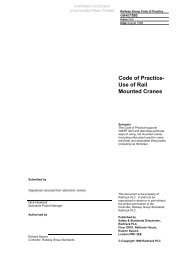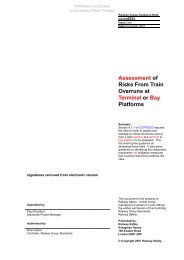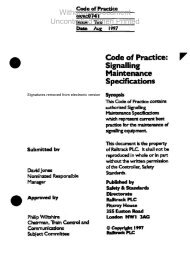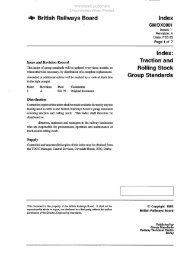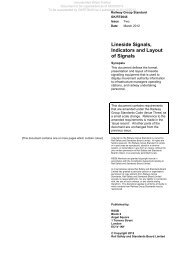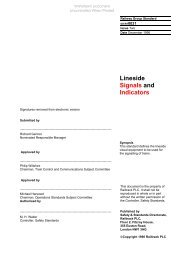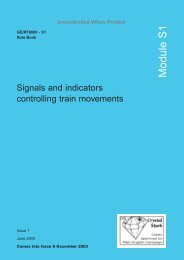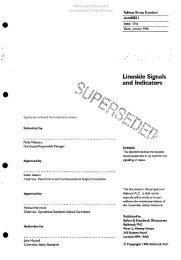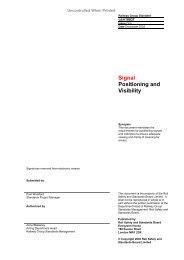General Information on Track Circuits - RGS Online
General Information on Track Circuits - RGS Online
General Information on Track Circuits - RGS Online
You also want an ePaper? Increase the reach of your titles
YUMPU automatically turns print PDFs into web optimized ePapers that Google loves.
Withdrawn Document<br />
Unc<strong>on</strong>trolled When Printed<br />
<str<strong>on</strong>g>General</str<strong>on</strong>g> <str<strong>on</strong>g>Informati<strong>on</strong></str<strong>on</strong>g> <strong>on</strong> <strong>Track</strong> <strong>Circuits</strong><br />
Railway Group Approved Code of Practice<br />
GK/RC0752<br />
Issue Two<br />
Date December 1998<br />
Page B25 of 25<br />
16.2.2 Auto Coupled Impedance B<strong>on</strong>ds<br />
The method used to couple the feed and relay ends of certain designs of track<br />
circuit into the track as shown in Figure B19. At the feed end, the reduced<br />
voltage appearing across the the tracti<strong>on</strong> winding is applied to the rails whilst at<br />
the relay end, the current from the track circuit passing through the tracti<strong>on</strong><br />
winding is usefully employed to drive the relay.<br />
IRJ<br />
To Next B<strong>on</strong>d<br />
Or Cross B<strong>on</strong>ding<br />
Figure B19<br />
IRJ<br />
To <strong>Track</strong> Relay Or<br />
Feed<br />
RAILTRACK B25<br />
OR<br />
To Rails<br />
To <strong>Track</strong><br />
Relay Or Feed<br />
A double rail A.C. track circuit with auto–coupled impedance b<strong>on</strong>ds is shown in<br />
Figure B20.<br />
Figure B20<br />
110V<br />
Res<strong>on</strong>ant B<strong>on</strong>d<br />
C<strong>on</strong>trol<br />
Local<br />
110V<br />
If the tracti<strong>on</strong> current in each rail is not equal, the imbalance results in a net flux<br />
in the ir<strong>on</strong> circuit, and if that flux is sufficient to saturate the ir<strong>on</strong> core, the track<br />
circuit current will be presented with a short circuit. It is therefore important to<br />
make the b<strong>on</strong>d as tolerant as possible of tracti<strong>on</strong> current imbalance and this is<br />
d<strong>on</strong>e by creating an air gap in the magnetic circuit. Such b<strong>on</strong>ds will tolerate 20%<br />
imbalance before saturati<strong>on</strong>.



